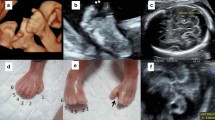Abstract
Fetal 3D USG image showing receded jaw and small ears at 31 weeks gestation. In the family history, elder sibling had a clinical diagnosis of Treacher Collins syndrome. Parents were apparently normal; however mother’s radiograph of skull was suggestive of mild hypoplasia of zygomatic arch. As the pregnancy was more than 20 weeks it was continued till term. Second image showed the post natal correlation of the USG finding. The severe micrognathia and microtia are clearly seen. The newborn suffered severe respiratory distress and expired at 36 h of life. Around 40% of the cases of autosomal dominant Treacher Collins syndrome have an affected parent. Family history may appear to be negative because of failure to recognize the mild expression of the disorder in family members. Careful examination and investigation of parents is warranted.
Similar content being viewed by others
Avoid common mistakes on your manuscript.
Fetal 3D USG image showed receded jaw and small ears at 31 weeks gestation. Family history revealed elder sibling having clinical diagnosis of Treacher Collins syndrome. Parents were apparently normal; however mother’s radiograph of skull was suggestive of mild hypoplasia of zygomatic arch. As the pregnancy was more than 20 weeks it was continued till term. Image shows the post natal correlation of the USG finding (Fig. 1). The newborn suffered severe respiratory distress and expired at 36 h of life.
Treacher Collins syndrome is characterized by hypoplasia of the zygomatic bones and mandible, external ear and lower eyelid abnormalities. About 40–50% of individuals suffer conductive hearing loss mainly due to the malformation of the ossicles and hypoplasia of the middle ear cavities. The diagnosis is clinical and radiographic. Three genes which are known to be causative are TCOF1, POLR1C, and POLR1D. Sequencing and deletion/duplication analysis of the TCOF1 gene identifies the pathogenic mutation in around 70–90% cases.
Most cases of Treacher Collins syndrome are inherited in an autosomal dominant manner. About 40% of the cases of autosomal dominant Treacher Collins syndrome have an affected parent. The family history may appear to be negative because of failure to recognize the mild expression of the disorder in family members [1]. Careful examination and investigation of parents is thus warranted in the presented case to identify those families with the familial form of TCS and at a high risk of recurrence.
When severe micrognathia is seen on an antenatal USG scan careful search for additional fetal malformations is warranted. These include looking for cleft palate, club foot, oligohydroamnios with pulmonary hypoplasia which is suggestive of Pierre Robin sequence. Also a careful look at the heart anatomy is required as the presence of cardiac defects raises possibility of velocardiofacial syndrome (22q 11 deletion syndrome). Other rare genetic syndromes with micrognathia include cerebro-costomandibular syndrome, oromandibular-limb-dysgenesis and oculo-auricular-vertebral spectrum syndromes. Hence, a complete fetal anomaly scan is essential in a case of severe micrognathia.
Reference
Marres HA, Cremers CW, Dixon MJ, Huygen PL, Joosten FB. The Treacher Collins syndrome. A clinical, radiological, and genetic linkage study on two pedigrees. Arch Otolaryngol Head Neck Surg. 1995;121:509–14.
Author information
Authors and Affiliations
Corresponding author
Rights and permissions
About this article
Cite this article
Kaur, A., Kaur, L. & Anne, R.P. Treacher Collins Syndrome: Before and After Antenatal Diagnosis by Ultrasonography. J. Fetal Med. 5, 249–250 (2018). https://doi.org/10.1007/s40556-018-0187-x
Received:
Accepted:
Published:
Issue Date:
DOI: https://doi.org/10.1007/s40556-018-0187-x





